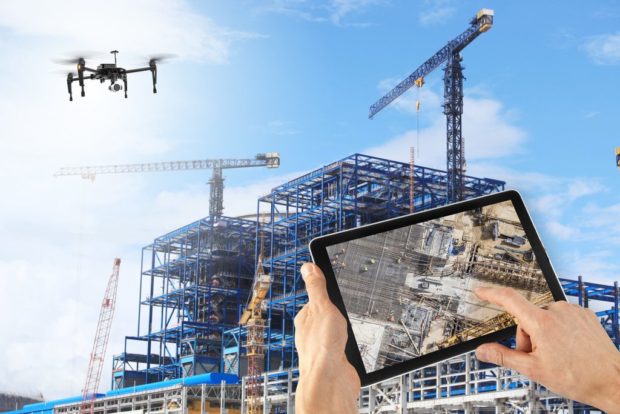It’s no doubt that drones are expanding the possibilities of construction firms to mitigate on-site risks. Considering that construction sites are potentially dangerous places, there is a need for effective risk control measures to reduce the number of deaths and injuries.
Every year, construction companies incur huge losses from on-site accidents. Quoting a report by OSHA, employers spend about $1 billion every week on direct workers’ compensation. The best way to reduce such losses is by adopting drones in construction.
With the use of drones in construction, firms can streamline safety inspections to protect workers from harm. In this article, we’ll look at how drones have contributed significantly in risk management. You will also get to learn how drones work.

How Drones Can Improve Safety of Workers in Construction Jobsites
When it comes to aerial imaging in construction, one benefit of drones is that they can capture accurate and high-quality images of a jobsite. From the data, construction firms can gain useful insights and make informed decisions regarding projects.
Here are some of the ways in which drones can improve jobsite safety.
1. Forecasts Potential Risks on Jobsites
Frequent safety inspections of construction jobsites bear crucial relevance in all projects. They help construction managers detect risks beforehand, giving them more time to create precautionary measures to contain them.
Identification of potentially hazardous situations in a construction site is one of the best ways to mitigate safety risks. With the help of drone technology, safety personnel can assess an entire construction project to determine the condition of structures.
During a site inspection, the drones can check the stability of structures such as scaffolding. Weak structures have caused many injuries and fatalities in worksites. With the help of drones, safety personnel can quickly identify such structures and repair them before any damage.
2. Automates Jobsite Inspection
In the past few years, when there was no drone technology, construction managers used helicopters to inspect construction sites aerially. With the advent of drones in construction, project managers can gain aerial insights into a building without necessarily going up.
In every construction site, there are usually tasks that might put employees at risk. They include scaffolding inspection and site surveys. Drones provide safer and more efficient ways to monitor highly dangerous areas that need regular manual inspections.
Project managers can use drones to automate the inspection of various construction aspects that are risky to human workers. That helps construction firms to save much time, allowing them to complete projects on time, including those under tight schedules.
3. Transportation of Goods and Equipment on Construction Sites
While most drones are small and light to fly at greater heights, some are large and heavyweight. Such drones can be used to deliver construction tools and equipment on top of tall buildings where workers cannot easily reach.
As drones transport objects throughout the construction site, they keep track of all the materials in transit. That makes it easier for project managers to account for every delivery made during construction. The technology is advancing, and we expect drones that can carry more weight.
4. Improves Collaboration between Project Stakeholders
Drones can also enhance collaboration within a construction team, rendering it useful for integrated project delivery systems. After collecting relevant data from job sites, construction managers, designers, workers, engineers, and project owners can easily access the information.
Another way in which drones can enhance collaboration is through site communication. Construction managers can generate drone maps and use them to communicate and collaborate with the interested parties. Individuals not in the construction site can get an idea of what’s happening in the field at any time.
5. Helps in Accident Investigations
Through drone mapping, construction managers can gain useful insights regarding on-site accidents whenever they happen. Drones can provide a more accurate picture of what transpired in the construction field compared to the eyewitnesses.
The drones’ ability to assess large construction sites makes them ideal for investigating every occurrence on job sites. As they are well-equipped with sensors and infrared cameras, they can capture detailed images that can help with investigations.
When a worker falls from a building during construction, project managers can use drones to measure the heights of fall. Taking the measurements manually can be risky, and may cause more harm to investigators.
6. Promotes Security Surveillance in Construction Sites
Theft of construction tools, equipment, and building materials will not only result in losses but also project delays. One of the best ways to minimize thefts in construction sites is by adopting drone technology.
Construction drones can provide a better experience when it comes to equipment security. Operators can fly drones over construction sites to quickly find out if all equipment is in their right places. Drone cameras integrated with face recognition software can also identify unauthorized personnel in job sites.
7. Facilitates Remote Monitoring and Real-Time Reporting
With the help of drones, a construction manager back at the office can monitor a project’s progress without necessarily moving to the construction site. Since drones provide high-quality aerial imaging, it would be the best way to update clients about their projects.
Besides remote monitoring, drones can also provide real-time reports to interested parties in a project. When inspecting a construction site, drones can send vital information to the project manager’s smartphone, tablet, or computer. For instance, if there is an accident on-site, project managers can get real-time information regarding the situation.
The Future of Drone Technology
Developers are building drones that utilize X-ray technology and WiFi signals to create high-resolution 3D maps. With these drones, construction engineers can establish accurate models of structures hidden behind the walls. Also, the development of drones that can carry weights of up to 400 pounds is underway.
While it’s the responsibility of construction workers to keep themselves safe, the incorporation of drone technology will make jobsites safer. Drones can improve the safety of workers by helping safety personnel to identify risks before they occur. They can also assess hard-to-reach areas considered risky for human workers.



